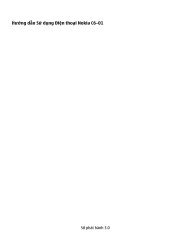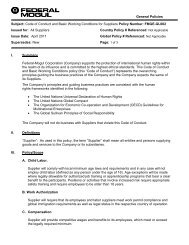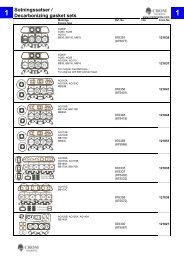You also want an ePaper? Increase the reach of your titles
YUMPU automatically turns print PDFs into web optimized ePapers that Google loves.
A<br />
ENGINEERING<br />
Load Capacity<br />
Some machining centers, such as rough grinding operations, are<br />
strategically designed <strong>for</strong> higher material removal rates. The need<br />
<strong>for</strong> aggressive feed rates requires higher load-carrying capacities.<br />
These loads can be properly distributed among the rolling elements<br />
by providing a permanent <strong>for</strong>ce called “preload” or "setting." Preload<br />
is the strategic removal of radial play within the bearing to ensure<br />
proper rolling element contact on both the inner and outer race.<br />
While <strong>Timken</strong> posts its load capacities in the product tables within<br />
this catalog, many applications often approach only a fraction of<br />
those limits. For example, workpiece finish may determine the feed<br />
rates needed in an application, thereby decreasing the importance<br />
of bearing capacity.<br />
<strong>Timken</strong> can assist in the final bearing selection to help you achieve<br />
your precision machining production goals. <strong>Timken</strong>’s staff of<br />
application engineers is ready to put its vast experience to any<br />
test <strong>for</strong> assisting our customers with the challenging bearing<br />
applications commonly found in the machine tool industry. To refine<br />
your search, please turn to the sections covering tapered roller<br />
bearings (Sec. B) or ball bearings (Sec. C) <strong>for</strong> more in<strong>for</strong>mation<br />
needed to obtain a complete <strong>Timken</strong> part number specification.<br />
TIMKEN ® MACHINE TOOL BEARING<br />
DESIGN<br />
From this introductory discussion and the additional technical<br />
content within this catalog, one can obtain an indication of which<br />
rolling bearing type should be further investigated to meet the given<br />
set of boundary conditions and per<strong>for</strong>mance expectations.<br />
Static Load - Co (lbs.)<br />
Fig. 6. Effect of preloading on ball bearing raceway contact.<br />
Figure 7 compares the levels of static capacity of ball vs. tapered<br />
roller bearings <strong>for</strong> the benefit of contrasting basic load capability<br />
of both bearing types.<br />
Tapered Roller Bearing (TS Metric)<br />
90000 Ball Bearing (2MM9100WI)<br />
67500<br />
45000<br />
22500<br />
0<br />
Unloaded<br />
Preloaded<br />
70 100 130 160<br />
Bore (mm)<br />
Fig. 7. Tapered roller bearing vs. ball bearing static capacities.<br />
400000<br />
350000<br />
300000<br />
250000<br />
200000<br />
150000<br />
100000<br />
50000<br />
0<br />
Static Load - Co (N)<br />
TIMKEN ® PRECISION TAPERED ROLLER BEARINGS<br />
The fundamental design principles of the tapered roller bearing<br />
make it an ideal solution <strong>for</strong> low-speed/high-load or low-speed/<br />
high-stiffness requirements of machine tool applications.<br />
True Rolling Motion<br />
The angled raceways of a tapered roller bearing enable it to carry<br />
combinations of radial and axial loads. True rolling motion of the<br />
rollers and line contact on the race allow the bearing to run cooler<br />
and improve spindle stiffness and accuracy as compared to other<br />
roller bearing types. The true rolling motion is the result of two<br />
design features: the taper of the roller and the contact between<br />
the spherical surface ground on the large end of the rollers and the<br />
race rib. The rollers are designed so extensions of the lines along<br />
the roller body converge toward the centerline of the bearing and<br />
meet at an apex on this centerline (Figure 8). As a result, there is<br />
no relative slip between the rollers and races.<br />
Cone<br />
(inner ring)<br />
Cup<br />
(outer ring)<br />
Consult the topics in this section addressing static and dynamic load<br />
capacity <strong>for</strong> more detailed in<strong>for</strong>mation regarding ball bearings and<br />
tapered roller bearings to refine your choice.<br />
Fig. 8. On-apex design results in true rolling motion at all points<br />
along the roller body.<br />
20 TIMKEN MACHINE TOOL CATALOG







